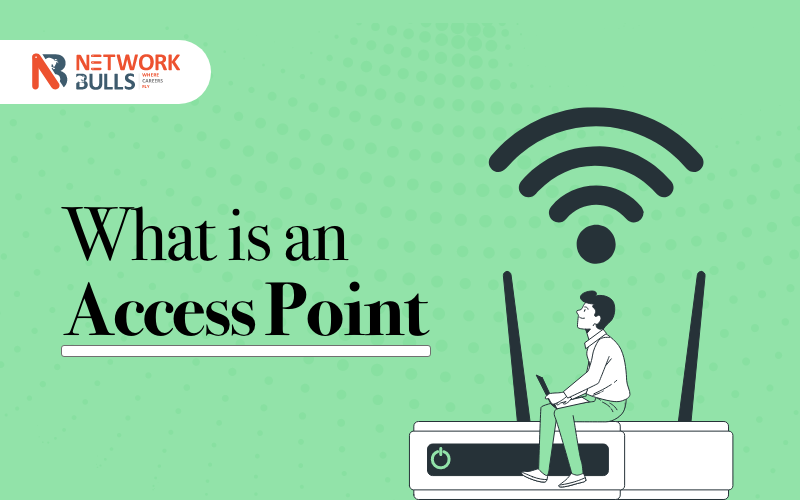What is Access Point? | Types of APs Configurations & Benefits of WAPs

An Access Point, as a device, is extremely useful in networking as it can handle a large number of connections simultaneously. This device is deployed in a large number of companies for networking solutions. This is due to the fact that Wi-Fi may be very useful for your home where your network does not have a large number of connections, but it is not the case in an office or commercial production facility where you have to support a large number of connections. Access Points particularly suit large offices as they can handle over 60 simultaneous connections each.
What Is an Access Point?
This networking device is used to create a WLAN (Wireless Local Area Network) in a large building, a business facility, or an office. Functionality-wise, an Access Point:
i. Connects to a wired router, switch, or hub through an Ethernet cable.
ii. Projects a Wi-Fi signal to a specific or designated area.
An Access Point can be installed at the front desk or reception counter of an office if it does not have a router within easy reach. In that case, you can run an Ethernet cable through the ceiling of the premises back to the server room. Access Points, as networking devices, can easily bridge wired and wireless networks.
What Is a Wireless Access Point?
Commonly termed as WAP (Wireless Access Point), it permits wireless-capable devices to connect to a wired network. As a device, WAP has the benefit of easy installation. It can be installed to connect all the computers in a given network very easily. It can:
i. Act as a portal for devices to connect to LAN.
ii. Extend the wireless coverage of an existing functioning network.
iii. Serve a large number of users that can connect to it.
Wireless AP (WAP) is currently being used for a wide variety of business purposes, including offices, manufacturing facilities, shopping malls, restaurants, condominiums, and multi-storied apartment buildings.
Types of Access Point Configurations
The types of Access Points depend upon their uses or functions. Access Points have three categories. They are:
i. Standalone Access Point: This device is similar to a switch or hub. In a network, it enables connectivity between different wireless devices and accepts frames from the connected devices. It converts the received frames before forwarding them to their destinations. For example, if a Standalone Access Point receives a frame formatted with the Wi-Fi standard but bears an address that uses Ethernet standards, it automatically formats the concerned frame with Ethernet standards before forwarding it to the destination.
ii. Multifunction Access Point: This is a combination of two or more devices. You can merge one or more devices to enable you to get extra functionalities alongside the existing functionality of the Access Point. For example, you can have a wireless router which ISP uses to provide the Internet connection as an example of a Multifunction Access Point.
iii. Controlled Access Point: It functions as the client of the WLAN controller or WLC. Also known as Lightweight Access Point or LWAP, it does not make any decisions to forward the data packets or information. When a Controlled Access Point receives a frame from the connected device, it forwards that particular frame to the WLC rather than forwarding it to the destination or the address.
Benefits of Upgrading to WAPs
You can gain several benefits by upgrading to WAPs. Subscribers, operators, service providers, manufacturers, and tool providers can benefit from upgrading to WAPs. We are listing below the major benefits of upgrading to WAPs:
i. Benefits for Subscribers:
Getting a wide range of services.
Fast access to services.
Serving a large number of subscribers or customers simultaneously.
ii. Benefits for Operators:
Higher network utilization resulting in greater revenue per user.
Sourcing gadgets and equipment directly from the manufacturers.
iii. Benefits for Service Providers:
Easy and less expensive maintenance.
Using standard tools (e.g., ASP or CGI) to generate content dynamically.
iv. Benefits for Manufacturers:
Supporting various types of networks and addressing a large number of customers.
Amalgamating new technologies into the system as and when they emerge or get introduced.
v. Benefits for Tool Providers:
Reusing and modifying existing tools or technological products to support WAP or integrating WAP support into existing tools.
In Conclusion
The device Access Point (including the WAP) has become an integral part of networking. It is getting rapidly deployed to handle, among other things, IoT devices and the management of IoT-generated data. Access Points and WAPs can help your office IT infrastructure support newer and next-generation technologies. They also help to segment network users. Network security is another reason why these devices are getting popular. Access Points support both Wi-Fi and Ethernet and use radio signals to provide connectivity.
Also check
- 100% Job guarantee courses in India
- CCIE Security Course Training in India
- CCIE R&S Course Training in India
- RECOMMENDED POSTS
-
Trending (0)

-
Network Bulls Placements (53)

-
CCIE (101)

-
CCNP (32)

-
CCNA (40)

-
Awards (14)

-
Network Bulls Reviews (53)

-
Informational Articles (74)

-
Technical Articles (26)

-
CCIE Success Stories (40)

-
Summer Training Courses (5)

-
CCIE Security Version 5 (34)

-
CCIE Data Center (19)

-
MCSE (3)

-
Industrial Training (10)

-
Microsoft Certification (3)

-
Ask NB (7)

-
Network Bulls Offers (6)

-
Best Institute for CCIE Training in India (118)

-
CCIE Training Courses (78)

-
DHCP (2)

-
Webinars (6)

-
Training (128)





















